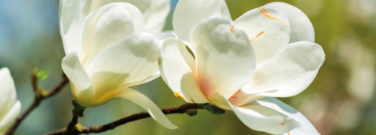Signs That Spring Has Sprung

By Christina P. Hooton
As winter’s gray days and snow begin to give way to warmer temperatures and sunlight, spring has a way of slowly but surely announcing its presence in nature. From blossoming trees to busy bees, here are some signs of spring’s arrival.
Bountiful Blossoms and Buds
Flowers of all shapes, sizes, and colors start popping up in spring. Some flowers, such as pearly white snowdrops and violet-hued crocuses, can start appearing early in the season when snow is still on the ground, while others, like plump peonies and star-shaped clematis, make their debut as late as May or June.
Although these flowers only last for a short period, they play an essential role in plant reproduction. Flowers attract pollinators like bees and other insects, which carry pollen that fertilizes the plant and helps it produce seeds. Animals or the wind then spread the seeds, so the plant continues to grow.
Spring flowers also like to show off on the branches of trees and bushes, like redbuds, magnolias, forsythia, and rhododendrons. Animals rely on blossoming trees for food and shelter. Some flowers eventually turn into fruit that falls to the ground for a variety of hungry animals and insects.
Busy Bees, Birds, and Babies
The beginning of spring is marked by a flurry of activity from animals and insects. Butterflies, like monarchs, return from their migration or emerge from hibernation and, along with bees and other insects, complete the critical task of pollinating flowers.
Many birds, such as swallows and nightingales, fly north after spending time as far away as South America, while others become more active after staying warm in their nests all winter. You’ll hear them singing in the early morning, and it’s no surprise as spring is an exciting time for them. This is when they find a mate, lay their eggs, and welcome chicks into the world.
Birds are not the only ones in baby mode. The mild weather and readily available food and resources during spring make it an ideal time for most animals to have babies, from rabbits and bears to toads and skunks.
Longer, Warmer Days
In the Northern Hemisphere, days start getting longer after the winter solstice in January and continue this way until the summer solstice in June. The light gained is much more noticeable in the springtime, though, because of daylight saving time, when we turn our clocks ahead by one hour.
The first official day of spring happens on the March, or vernal, equinox every year. This is when the Sun moves from south to north across the Earth’s equator. On this day, there is nearly an equal amount of daylight and darkness. After this point, countries in the Northern Hemisphere tilt closer to the sun, and temperatures start getting warmer.
With its added daylight and burst of activity, spring is a great time to observe and discover the wonders of nature all around us.
Discussion Questions
- Track the progress of spring right in your backyard. Take note of the flowers and plants growing, animals and insects becoming more active, and daylight increasing.
- Why do certain birds and insects fly south for the winter and return to northern habitats in the spring?

